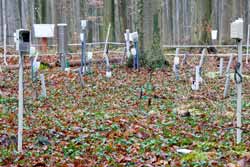Wireless sensor network monitors microclimate in the forest

What effect does climate change have on our local forests? What types of trees will be suitable for which geographic location? And how great is the pollution level here? Forestry scientists are conducting „forest monitoring” procedures:
They continuously record parameters such as soil humidity or pollutant penetration at permanently installed monitoring stations. The results of such examinations contribute to maintaining the ecological stability of the forests over the long term. The problem: Not only are the wired measuring devices complex to install and maintain, they also hinder silvicultural work in the forest.
In the future, technologies from the Fraunhofer Institute for Microelectronic Circuits and Systems IMS could enable differentiated analysis without any bothersome cables. Scientist from the institute in Duisburg installed a new type of system for microclimatic monitoring on the grounds of the Northwest German Forestry Testing Facility in Göttingen, Germany. “We are using a wireless sensor network so we can measure relevant parameters within an area at many sites simultaneously,” explains Hans-Christian Müller, group manager at the IMS. This way, we receive a very detailed picture about the environmental conditions on site, without much installation effort. Depending on which values they are to measure – for example, soil moisture content, air temperature or the moisture in the leaves – different sensor nodes are inserted into the soil or affixed to branches.
If required, the measuring positions can be changed without much effort. The intelligent mini-computers automatically form a network and control the transmission of measurement data within this network. The results are transmitted by cellular radio to a central tree stock database. To facilitate this, a mobile cellular modem is connected directly to the sensor network.
Providing power to the sensor nodes poses a particular challenge. Mounting solar cells to the sensors – a favored solution in other agrarian and forestry applications – is not an option due to the low penetration of sunlight under the leafy canopy of the trees. That‘s why, to date, there has been no alternative to batteries that have to be replaced regularly. Researchers, however, managed to significantly increase battery life, keeping maintenance requirements within reasonable limits: “We adapted the software design accordingly and now have operating times of 12 months,“ says Müller. A software solution integrated into the sensors ensures that the radio nodes are for the most part in an energy-saving sleep mode. They are active only during the measurement and data transmission process. The measurement intervals can be set to be variable. Parameters that change slowly such assoil moisture need not be measured as often as air temperature, for example, which is subject to larger variations. Since data transmission requires the most energy, the measurement values are calculated as early as the sensor node. This reduces the data volume.
The new technology is already in use in Göttingen as part of the joint project “Smart Forest”. The project aims to optimize forestry processes with the aid of microelectronic components. The researchers from IZM will be introducing their results on the “Smart Forests” as well as other developments on the industrial application of wireless sensor networks at the Messe Sensor + Test tradeshow from June 7 – 9 in Nuremberg, Germany, in Hall 12, Booth 231.
Media Contact
All latest news from the category: Ecology, The Environment and Conservation
This complex theme deals primarily with interactions between organisms and the environmental factors that impact them, but to a greater extent between individual inanimate environmental factors.
innovations-report offers informative reports and articles on topics such as climate protection, landscape conservation, ecological systems, wildlife and nature parks and ecosystem efficiency and balance.
Newest articles

NASA: Mystery of life’s handedness deepens
The mystery of why life uses molecules with specific orientations has deepened with a NASA-funded discovery that RNA — a key molecule thought to have potentially held the instructions for…

What are the effects of historic lithium mining on water quality?
Study reveals low levels of common contaminants but high levels of other elements in waters associated with an abandoned lithium mine. Lithium ore and mining waste from a historic lithium…

Quantum-inspired design boosts efficiency of heat-to-electricity conversion
Rice engineers take unconventional route to improving thermophotovoltaic systems. Researchers at Rice University have found a new way to improve a key element of thermophotovoltaic (TPV) systems, which convert heat…



